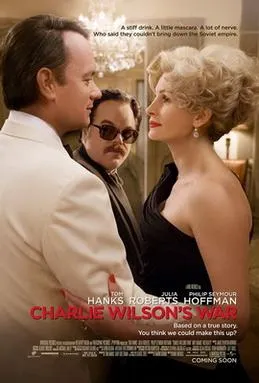Historical accuracy of Charlie Wilson's War

Historical accuracy of Charlie Wilson's War

Characters
Charlie Wilson (Tom Hanks)
Accurately portrayed as the real Texas Congressman known for his flamboyant lifestyle and pivotal role in securing massive funding for the Afghan Mujahideen through congressional committees.
Gust Avrakotos (Philip Seymour Hoffman)
Accurate portrayal of the real CIA agent who, despite bureaucratic friction, managed the operational side of arming the Mujahideen, working closely with Wilson. Hoffman's performance was highly praised.
Joanne Herring (Julia Roberts)
Accurately depicted as the real, influential socialite and honorary consul who initially spurred Wilson's interest in Afghanistan and used her connections, particularly in Pakistan.
President Zia ul-Haq (Om Puri)
Accurately portrayed as the Pakistani leader who allied with the U.S. to funnel weapons to the Mujahideen, serving Pakistan's own strategic interests against the Soviets.
Rep. Clarence "Doc" Long (Ned Beatty)
Accurately represents the real Congressman whose key committee position allowed Wilson to significantly increase funding for the covert operation.
Michael Vickers (Christopher Denham)
Accurately portrays the real paramilitary officer credited with developing the effective strategy for arming the Mujahideen, including advocating for advanced weapons like Stingers.
More characters
Bonnie Bach (Amy Adams)
Represents the real Bonnie Bach, who was a key part of Wilson's staff managing the complex operation and logistics.
Harold Holt (Denis O'Hare)
Represents the CIA presence in Pakistan coordinating the operation, likely based on real station chiefs but potentially composited or fictionalized.
Cravely (John Slattery)
Represents the CIA bureaucracy and superiors Avrakotos clashed with; likely a composite or representative figure rather than a specific named individual.
Story
Soviet Invasion of Afghanistan (1979)
The film is accurately set against the backdrop of the Soviet invasion and subsequent decade-long war.
Wilson's involvement sparked by Herring & Pakistan visit
Accurately depicts how Herring's influence and Wilson's visit to Afghan refugee camps in Pakistan motivated his deep commitment to the Mujahideen cause, as detailed in Crile's book.
Operation Cyclone (CIA program)
The film accurately centers on this real, large-scale covert CIA operation to arm and finance the Afghan resistance against the Soviets.
Wilson securing huge funding increases via committees
Wilson's skillful political maneuvering within the House Appropriations subcommittees to dramatically increase covert aid from millions to eventually over $500 million annually (matched by Saudi Arabia) is historically accurate.
Collaboration between Wilson, Avrakotos, Herring
The unlikely but effective partnership between the Congressman, the CIA operative, and the socialite was real and central to the success of Operation Cyclone.
Providing advanced weapons (e.g., Stinger missiles)
The eventual supply of crucial weapons, including shoulder-fired Stinger anti-aircraft missiles, significantly hampered Soviet air power and is accurately depicted as a key turning point, though the film might simplify Wilson's initial stance.
Cooperation with Pakistan, Israel, Egypt, Saudi Arabia
Accurately shows the complex international coalition needed to procure weapons (often Soviet-made via Israel/Egypt), fund the operation (Saudi Arabia), and deliver aid (via Pakistan's ISI).
Soviet withdrawal from Afghanistan (1989)
The film accurately portrays the eventual Soviet defeat and withdrawal, partly attributed to the heavy costs inflicted by the CIA-backed Mujahideen.
Lack of U.S. funding for post-Soviet reconstruction
Accurately depicts Wilson's unsuccessful efforts and frustration in trying to secure funding for rebuilding Afghanistan (schools, infrastructure) after the Soviet withdrawal, warning about future instability.
Wilson's playboy lifestyle & ethics investigation
The film acknowledges Wilson's well-documented reputation for womanizing and partying, and briefly touches upon a real investigation into alleged cocaine use (though he was cleared).
Simplification of Mujahideen groups / Pakistani ISI role
Some critics argue the film simplifies the diverse and often conflicting Mujahideen factions and downplays the extent to which Pakistan's ISI directed aid towards more Islamist groups.
Focus on Wilson/Avrakotos/Herring as primary drivers
While their roles were crucial as depicted in Crile's book, some historians argue the film might overemphasize their individual impact compared to broader Reagan administration Cold War policies.
Setting
Washington D.C. (Capitol Hill, 1980s)
Effectively recreates the corridors of power, congressional offices, and political atmosphere of Washington D.C. during the late Cold War.
Houston, Texas Social Scene (1980s)
Captures the affluent, politically connected world of Joanne Herring in Texas.
CIA Headquarters (Langley, VA)
Represents the bureaucratic environment of the CIA where Avrakotos operated and clashed with superiors.
Pakistan / Afghan Refugee Camps (1980s)
Visually represents the settings in Pakistan (Islamabad, Peshawar frontier areas, refugee camps) crucial for the operation's logistics and Wilson's formative visit. (Filmed largely in Morocco).
1980s Fashion, Technology, Decor
Costumes, hairstyles, office technology (computers, phones), cars, and interior design accurately reflect the aesthetics of the 1980s.
Cold War Political Climate
Successfully conveys the context of the late Cold War, the focus on combating Soviet influence, and the dynamics of covert operations.
Use of Archival/News Footage
Integrates some real news footage effectively to provide context for the Soviet-Afghan war, enhancing authenticity.
